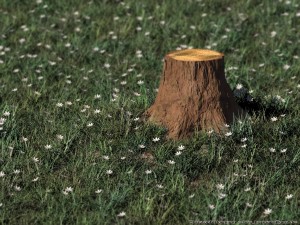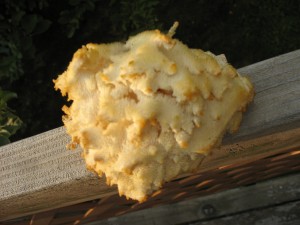 I can not walk by a stump without thinking, that stump could be growing mushrooms. Stumps are the most under utilized substrate (material) for growing mushrooms that I see. Choosing the right mushroom for the stump is important, but many mushrooms will grow on a variety of stumps. Cottonwood stumps in particular will host a wide variety of mushrooms. The mushroom consumes the stump and the root system, and mushrooms can be harvested for years on a seasonal basis. The root system gives a place for the mycelium to hide in bad weather, and a place to get moisture for fruiting when the weather is ripe for the flush.
I can not walk by a stump without thinking, that stump could be growing mushrooms. Stumps are the most under utilized substrate (material) for growing mushrooms that I see. Choosing the right mushroom for the stump is important, but many mushrooms will grow on a variety of stumps. Cottonwood stumps in particular will host a wide variety of mushrooms. The mushroom consumes the stump and the root system, and mushrooms can be harvested for years on a seasonal basis. The root system gives a place for the mycelium to hide in bad weather, and a place to get moisture for fruiting when the weather is ripe for the flush.
 It bothers me to see stumps ground up, pulled out of the ground, or chemically removed, when they could be inoculated. Food can be harvested for years, and the stump is reduced to great soil for planting. When included with inoculation of the tree material removed, food can be harvested from a process that usually involves a lot of waste, and filling of our landfills.
It bothers me to see stumps ground up, pulled out of the ground, or chemically removed, when they could be inoculated. Food can be harvested for years, and the stump is reduced to great soil for planting. When included with inoculation of the tree material removed, food can be harvested from a process that usually involves a lot of waste, and filling of our landfills.
Good candidates are oysters for hardwoods, and conifer corals for conifers. Inoculation can be with dowels or various spawns. This is another great way that mushrooms can help reduce waste while providing a usable product.

Couple of questions:
After inoculating a stump how often do you check it for flushes?
Will Shiitake and Reishi grow in Montana using this method?
Do you know of any mushrooms that boost immune or help with allergies?
The stump will flush at the same time as other patches of the same species flush. You should write an article on how self inoculation can be used as an indicator of when to go hunting in the wild.
IIRC we just don’t have the weather for them. Maybe if you created a little stump greenhouse you could do it!
The stumps will start to flush 9 to 12 months after inoculation. Inoculation here in Montana should be done between March and October.
Reishi and Shiitake are excellant for the immune system. Reishi is my favorite, but should be using shiitake more since food is a better way to to get the full properties of mushrooms. I will look into allergies, but boosting the immune system is probably the best way since allergies are mostly caused from the immune system over reacting.
I would be curious as to how much you would have to protect stumps to grow reishi and shiitake here! Inoculated logs however would have to be protected and are usually brought inside through the winter.
Hi there,
I have just put 500 shiitake plugs into oak stumps on my property. The trees have been down for about 2 months. I was wondering if you think it’s necessary to girdle the stumps with a chainsaw to make sure they are dead and not trying to fight off the fungal “infection”. Most of the stumps are cut pretty close to the ground (12-16 inches) but one is about 3-4 feet high. I’m most worried about this one, as I sunk half of my plugs into it!
cheers,
Kevin
Hi Kevin,
In his book “Growing Gourmet and Medicinal Mushrooms”, Paul Stamets of Fungi Perfecti (link on homepage) recommends girdling stumps to improve the success of inoculations. In a pamphlet that came with my shiitake plugs from Fungi Perfecti, the instructions say “Stumps–particularly those of newly fallen trees–should be girdled, i.e. the bark from the bottom 2″ should be removed to insure that the stump does not continue to grow after plugging.”
So, I would have to agree with Paul, since he is an expert. I would be very interested to see and hear how this works for you. Thank you for your interest,
Dean
I have been very interested in inoculating oak stumps on my property with the intention of utilizing these stumps as a way to integrate mushrooms into my forest food system. I am told that, however, oak logs must be freshly cut in order to inoculate properly, but I wonder if this is the same with stumps, as root systems often continues to live for a time even after the tree has been removed.
The existing oak stumps on my property were created when I logged wood for my barn about 18 months ago. Is it a waste to inoculate these stumps at this point? They are nice stumps from large trees and I would like to utilize them. Thank you.
Hello, and Welcome to Montana Mushrooms.
I would agree that the stumps are still alive and viable for inoculation.
Where are you located? Fortunately there are a lot of mushrooms that grow well on oak.
I love to grow mushrooms on stumps because there is a lot of food left in the ground and it helps to turn the wood back into soil. They also seem to get there own water and nutrients from the root ball and system and take less attention than logs.
What do you have to lose by trying? Spawn is pretty cheap considering that you usually just inoculate the outer ring by the bark.
Good luck and please let us know how you do,
Dean
Thanks, Dean. I am in West Virginia and do have a lot of oak. I am going to work on this some today, and will let you know how it goes. One other question I have: what about keeping the stumps moist for fruiting? Unlike an inoculated log, I can’t soak these stumps. I am planning to inoculate today bc we are looking at a rainy week ahead. Is there anything else I should consider here? Will the roots keep the stumps moist on their own?
Also, I had a friend suggest that I cut the top of the stump back a few inches and then inoculate. Any thoughts a hit that? Thanks for the help!
I have a boxelder stump in wis. and is there a mushroom that might grow in this?
Hello and I apologize for the late answer.
Did you find something to grow on it yet?